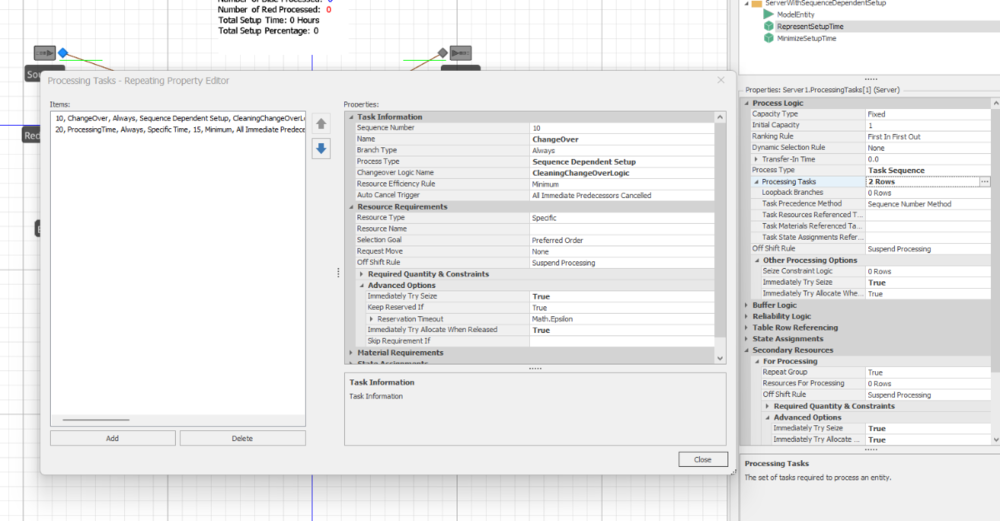Search the Community
Showing results for 'matrix construction'.
-
Hi there, is there a way to import data from excel into a string list so that i can create a large changeover matrix without having to individually enter each item. Following that, id there a way to populate a change over matrix from excel?
-
- changeover logic
- string list
-
(and 3 more)
Tagged with:
-
Hello, I'm having strugles trying to configure the setup for the next process: some entities have a diferent processing time and setup time, before to enter to be processed in the workcenters, the workcenter have to be cleaned. I looked the simbit, "ServerWithSequenceDependenrSetup" but I'm confused with the configuration of the processing task. I dont know why we have two lines and o why only one have associeted the change-over matrix.
-
Hi all, I have a model with several servers, each with their own Changeover Matrix for cleaning between jobs. This is done by a Sequence Dependent Setup within the Servers Task Sequence steps. This is working fine when the Cleaning is either done 100% Automatic or 100% Manual with a Worker called as a Secondary resource. Some servers however require partial support from a Worker. For example a COMatrix of X mins needs to include 5 mins support from a Worker at the start and 10 mins support from a worker at the end of the Changeover period, with the middle X - 15 mins in the middle of the CO cleaning period (There are other more complex examples too where the operator will be required half way through the process too to empty the cleaning waste container). Is there a way of saving the COMatrix time, rather than running this delay, so that I can then build an add on process or add further task sequences to break the time into its Automated and Manual Components? Thanks in advance for any suggestions. J
-
Hi everyone, I am trying to model entities moving from 10 origins (sources) to 10 destinations (sinks). The entities are simultaneously created according to a certain mix (Entity1 (85%), Entity2 (10%), and Entity3 (5%). However, the number of entities created per event is according to a certain distribution. There is an OD-matrix that captures the number of entities moving from origin to a specific destination. Let's say there are 10 destinations, than the destinations of the Entities are determined according to the OD-matrix: Entity1 and Entity2 can move to any of of the sinks. Entity3 can only move to one specific sink. One solution I came up with was to add weights to Connectors and assign destinations using TransferNodes, but I think that this is very inefficient. I then started to work with DataTables, but I cannot figure out how to probabilistically assign the destinations of the entities. My question is: how to model the probabilistic destination assignment of Entities using DataTables in such a way that it is relatively easy and flexible to add or remove Sources/Sinks? I have added the model for you to see, I hope that you can help me! Many thanks in advance Simple_OD_creation.spfx
-
I want to be able to schedule events for the future without having to define a separate timer for each possible time this will happen. Ideally i'd like to be able to index into a vector of timers to start one, so it can be dependent on a state variable. One use of these would be recurring tasks, for instance, while a patient is in post-surgery, they will be administered medicine every r hours. This is dependent on them exiting surgery (it doesn't begin at a specific time), so a rate table doesn't really work, and that would run into a similar problem of having to define different rate tables for each patient type and recurring tasks (potentially hundreds). Any ideas?
-
Hi, I was modelling changes between different setups using a changeover matrix and I noticed that the entries entered cannot be in the form of a random distribution. Is there any way that I can change any settings of the matrix properties in SIMIO so that it can accept random distributions as its entries? Thank you!
-
Does someone know how to create a changeover matrix property?
-
Hi, We have a model where we have multiple entity states. This creates interface challenges in defining and populating these states or changing many of them at a time. My question is, can the UI be bypassed in some way using some kind of batch operations? For example suppose I want to assign 150 entity states using string construction and naming conventions easily set up in a spreadsheet. Is there a way to define all those states and import them from a file rather than hand editing each one in the Definitions UI? Another example is I want to set large numbers of these states at appropriate points in processing. Is there any way to do so by just importing name value pairs from a file rather than hand editing each one and copy pasting from a spreadsheet built up accordingly. Thanks Very Much, Jim
- 2 replies
-
- state array
- repeat group
-
(and 4 more)
Tagged with:
-
Hi Jeff and Gocken, Thanks for both of your replies. @Jeff, Thanks. This has helped me a bit. I hadn't used a vector yet, and your example has helped me along. Thanks for that. I'll try converting it into a matrix, so I can save more information on each row. @Gocken, I did exactly as you suggested, but it is always good to get some confirmation that you're on the right track . I'll update this thread when I (inevitably..) run into new issues. Kind regards, Tom
-
In my model, there are 2 types of entities created by 2 sources: Entity Type A and Entity Type B.The changeover setup time matrix is something like Previous Entity Type A TypeB Incoming Entity Type A 0 Random.exponential(15) Type B Random.Exponential(10) 0 I know how to do it using the changeover matrix, but apparently, the changeover matrix can't take random distributions. May I have some suggestions as to how to go about this? Thank you!
-
Alternatively, you can have a Changeover element where you specify the Use Changeover Matrix property as 'False'. This allows you then to specify From Value Type (of an operational attribute) to a To Value Type and a Setup Time expression. The From Value Type and To Value Type may be specific values or simply to a 'Same' or 'Different' value.
-
Simio can not utilize distributions as the sequence dependent setup times in changeover matrix. You have to handle this manually using related data tables.
-
Assigning the server a new symbol after the processing is finished
qq2017 replied to qq2017's topic in SI General Discussions
As my major is Railway Engineering, I am trying to simulate the construction process of a railway station. I mean the construction of railway tracks in the station, not the station buildings. For example: For simulating the construction process of a turnout, it needs three main things: machine, workforce, and material. I have used the turnout as a server, and I have used 3 entities coming from 3 resources to the server (the turnout). As the entities arrived the server, it starts processing and its symbol will be changed to green box. I have assigned a turnout symbol for the processing step instead of the green box, and I need to keep this symbol during the whole simulation process as it represents the constructed turnout. -
Shortest queuing time including changeover time
Travis replied to Travis's topic in SI General Discussions
I already tried it. But there are no examples related in my case in Simbits and Examples. Isn't it possible to make changeover trigger like every 5 entities or 6 entities or 7 entities and so on? I tried many methods below. 1) data - changeover matrix --> but the error happened. I followed Principle11. Even I tried to modify the Principle11 file. However, when I make 4 entities, errors happened. Only when there are two entities A and B can be processed. 2) Definitions - states --> make a real state variable. After that, I made a process decide, assign, assign. For using Ranking rule, I made like decide(tmpM1<=5)-->assign(modelentity.priority+1)-->assign(tmpM1+1) repeat it. And if decide is false, decide(tmpM2<=5)-->assign(modelentity.priority+1)-->assign(tmpM2+1) repeat it. But I couldn't solve the changeover trigger like this method. Now, Changeover function is a problem and also trigger can't be made. I did my best enough. But actually, there are not enough datas for studying Simio yet. -
Hello, How big are the tables you're running in Simio? Dealing with a 2-milion rows table feed by a csv file takes 4 GB in RAM memory (for each table). In case you are using manual import with such tables your PC gets hardly reactive. Automatic import slows down the system only when running the model, obviously. Then, defining a similarly sized matrix takes roughly the same amount of memory, approximately 3.5 GB RAM. One might think that a matrix data structure should be far much lighter than a table's, but it is not, apparently. A curious thing, memory occupancy remain the same if you quit the model, only re-starting Simio the amount of memory used is cleared. It migh be the backup function. HAs anyone found any trick to work comfortably with by those really huge data structures? regards,
-
Huge problem! help please
antonio6vieira replied to antonio6vieira's topic in SI General Discussions
Thank you for your reply! Forgive me if I was not being clear. As I said I need to use the API to set the number of channels because I need to test (Simulation Experiences) my model with different numbers of channels (10,100,1000,10000, etc) -> I'm not going to place, connect and edit 10000++ objects... That being said, I know I can use something like "Channel1.WIP", but since I don't know the number of channels, I don't know if the driver is examining the channel1 or the channel999... The array implementation I'm using is very handy because it lets me know where a type of product is (e.g. If I want to know if product 2 is on channel 5 I only need to go to array[2,5] and see the quantity). To help clarify what I'm talking about I attached my model. The global array is the state matrix PlaceOfREF and the processes that update this array are on the processes category ChannelComunication Any ideas? I'm really having a lot of probelms with this bosch_RASM_tobias.spfx -
In Enterprise you can update a table state using an Assign Step. In other Simio versions you can have a matrix array that is initialized from a table, then use an Assign Step to update the state values that would correspond to a particular cell.
-
Thanks for immediate reply David, I just find the route step option myself, but it is good to know that there is no other elegant option. But as I want to transfer some entity to the node from node list not using a path, I use this construction. Route -> Assign (NodeState:=Model.Entity.DestinationNode) -> Transfer (to node: NodeState) I would be nice if we can just pick a random node form list with something like this List.MyListName.random Something we can do with populations.
-
I’ve got a follow up question of my own. What is the use-case of the table property? I can define a table property on an object, and then set that property value to a table in my “parent” model in my object instance. In my object’s processes definitions, I can search the table and find all the rows. However, I can’t seem to do anything with the rows found. For example, I’d like to get a field from each row and assign it to a state variable. I tried referencing the result using TableProp[1,1] , but I get an “incorrect number of parameters” error . I can’t set a state matrix to the table property either So, what can I do with a table property? Thanks, Adam
-
can we use random numbers in the changeover matrix?
-
Yup! It looks to me like it can be created through the 'right-click' context menu for setting properties. 1) Add a workstation to your model. 2) Set 'setup time type' to sequence dependent. This will allow you to set a changeover matrix on the workstation. 3) Right click on the 'Changeover Matrix' label, select 'Set Referenced Property', then select 'Create New Referenced Property'.
-
Hello, I am interested in having routing information read into a model from an Excel spreadsheet. The basic problem is that I have several entity types that must be processed at one of many servers. There are capability restrictions (i.e. EntityA can only be processed at Server1, EntityB can be processed at Servers1, 2, 3, etc). I have a “capability matrix” as input data that is a table in Excel showing where each entity type can be processed. In the Simio model, I am using a transfer node to route each entity to an available (and capable) Server by using the “Select from list” entity destination. My customer is interested in analyzing the impacts of changing capabilities of the servers. Currently, all other inputs to the model are fed in using bound Excel files. However, the routing logic requires lists, which I have to manually create and/or edit. I would like to have these bound to a data table, or somehow reflect the data in the master input Excel file. Thoughts? Thanks, Adam
-
The Simio object framework is built on the same basic principles as object oriented programming languages; however these principles are applied within a modeling framework and not a programming framework. For example the Microsoft development team that designed C# applied these basic principles in the design of that programming language. Although these same principles drive the design of Simio, the result is not a programming language, but rather a modeling system. This distinction is important in understanding the design of Simio. Simio is not simply a simulation modeling tool that is programmed in an OOP language (although it is programmed in C#). Likewise it is not simply a set of classes available in an OOP language such as Java or C++ that are useful for building simulation models. Simio is a graphical modeling framework to support the construction of simulation models that is designed around the basic object oriented principles. For example when you create an object such as a “machine” in Simio, the principle of inheritance allows you to create a new class of machines that inherits the base behavior of a “machine”, but this behavior can be modified (overridden) and extended. Whereas in a programming language we extend or override behavior by writing methods in a programming language, in Simio we extend or override behavior by adding and overriding graphically defined process models. This distinction between object oriented modeling and object oriented programming is crucial. With Simio the skills required to define and add new objects to the system are modeling skills, not programming skills.






